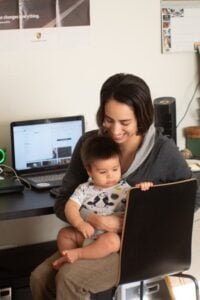 As we all know, back to school season is in full swing and this year more than ever, it feels more daunting and complex…but it doesn’t have to be! It’s not uncommon to have some anxieties and reservations about what to do with their children this academic year. Making the decision to opt for virtual learning can be bittersweet; on the one hand, your child is safe at home and on the other hand, you’ll have to juggle the demands of work and helping your child learn. So, here are a way tips and trick to make the school day/workday go by smoothly!
As we all know, back to school season is in full swing and this year more than ever, it feels more daunting and complex…but it doesn’t have to be! It’s not uncommon to have some anxieties and reservations about what to do with their children this academic year. Making the decision to opt for virtual learning can be bittersweet; on the one hand, your child is safe at home and on the other hand, you’ll have to juggle the demands of work and helping your child learn. So, here are a way tips and trick to make the school day/workday go by smoothly!
A Workspace
Create a workspace that your kids can call theirs—it is important that they have a designated space for learning. Stock it up with all the materials they might need for classes, creativity breaks and for having fun! This workspace should not be too far from your own, but far enough that they are not able to distract you from your work.
A Schedule
Because learning from home is such a big shift, it’s important to keep a routine and maintain consistency. Create and establish a schedule for the entire family to follow, including showers, breakfast, chores, breaks, lunches. Give your children a full “school” day to mimic your working schedule—this will help your child know the distinction between work and play. It helps if, as the parent, you base your schedule around your child’s because class schedules may vary. Make sure to stick to the schedule and don’t work beyond the end of the “work/school” day!
Breaks and Lunches
Giving yourself and your children breaks between classes and projects are necessary. Make sure to take breaks with your children and share those moments. This is especially important because doing so models proper self-care behavior. If your living space allows for it, go outside during breaks and allow them to run around and play for a few minutes. Learning is hard enough and being cooped up inside make it extra difficult for a child to concentrate.
Breaks are extra important for younger children, as older children and teens are able to focus on tasks for longer periods of time. It is recommended to give younger children a 10-minute break after 20-30 minutes of classwork and assignments. As for older children and teens, 15 minutes every 45 minutes.
A Common Area
Have a common area that everyone can use together—this can be the living room, dining room, etc. This will be a space when you can take your breaks, eat your lunch, hang out after work/school. This is also a great place to put the household schedule on display, this way it is visible to everyone and they can refer to it at any point in the day.
Boundaries
Boundaries are extremely necessary in order to have an effective work/school environment. Make sure to explain and enforce the boundaries you have created, whether they be physical or verbal boundaries. Physical boundaries can be things like a sign on the door to let them know that they may not enter (emergencies excluded), a curtain separating spaces, locks on doors. Verbal boundaries can be things like not shouting and yelling while family members are working/learning, not interrupting another family member when they are in a meeting, etc.
Children, especially smaller ones, will try to test those boundaries and break your rules, but it’s important to handle the situation empathically. Understand that this is a new situation for them, and they are trying to navigate it the best they can—just like you!
______________________________________________________________________________
In this time of uncertainty and newness, it’s important to pay attention to our bodies and give ourselves time and space to recuperate from the demands of school and work. Be patient with yourselves and your children, and don’t forget to ask for help if you need it! Read more about how to support your child with virtual learning here: https://www.childrenandscreens.com/media/press-releases/covid-19-and-at-home-learning/
By: Hilary Paredes, MHC Intern
